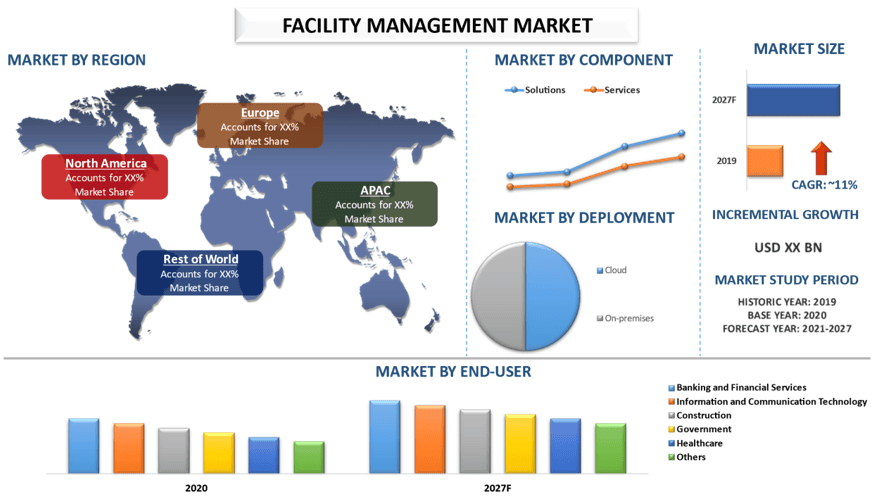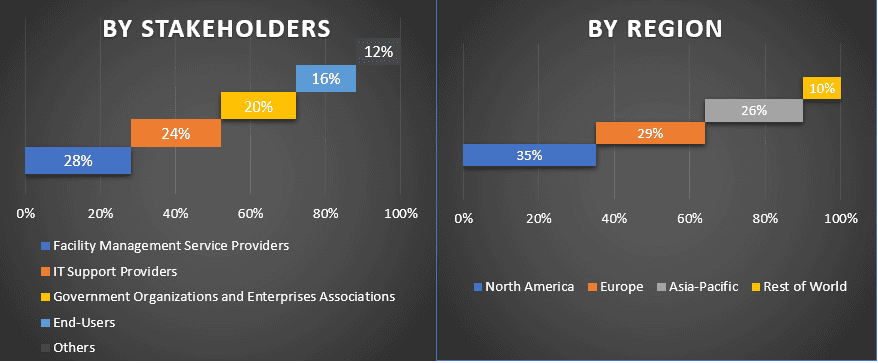- Inicio
- Acerca de nosotros
- Industria
- Servicios
- Leyendo
- Contáctenos
Análisis actual y pronóstico del mercado de Facility Management (2021-2027)
Énfasis en Componentes (Soluciones y Servicios); Implementación (Nube y On-premise); Tamaño de la Organización (Grandes Empresas y PYMES); Usuario Final (Banca y Servicios Financieros, Tecnologías de la Información y Comunicación, Construcción, Gobierno, Sanidad y Otros); y Región y País

SOLICITAR PDF DE MUESTRA GRATUITO
Es probable que el mercado mundial de gestión de instalaciones muestre un crecimiento de alrededor del 11% durante el período previsto. Los factores clave que influyen en el crecimiento del mercado de gestión de instalaciones son el aumento de la inversión en infraestructura, la creciente demanda de servicios de valor añadido y la necesidad de cumplir con las normas ambientales y reglamentarias. Además, la creciente adopción de soluciones basadas en la nube y las iniciativas gubernamentales de apoyo para el desarrollo de ciudades inteligentes y centros de negocios ha alentado a las industrias de usuarios finales a invertir en servicios de gestión de instalaciones para la planificación estratégica, la implementación de procedimientos de salud y seguridad, la organización del mantenimiento y la seguridad de las instalaciones, lo que ha provocado un aumento en la gestión de instalaciones. Además, los proyectos de infraestructura en curso en todo el mundo han contribuido significativamente al crecimiento del mercado de gestión de instalaciones. Por ejemplo, el Primer Ministro de la India, Sr. Narendra Modi, anunció un plan maestro de USD 1.5 billones para la conectividad multimodal en octubre de 2021, con el objetivo de desarrollar infraestructura para reducir los costos logísticos y mejorar la economía. Tipos similares de proyectos de infraestructura están en curso en todo el mundo. Por lo tanto, crea enormes oportunidades para los actores clave del mercado de gestión de instalaciones.
International Business Machines Corporation, Oracle Corporation, SAP SE, Fortive Corporation, Service Works Global, Causeway Technologies, Archidata Inc., Facilio Inc., Apleona Group GmbH y UpKeep Technologies Inc. son algunos de los actores clave en el mercado. Estos actores han realizado varias fusiones y adquisiciones junto con asociaciones para facilitar a los clientes productos/tecnologías innovadores y de alta tecnología.
Perspectivas presentadas en el informe
“Entre los tipos de implementación, la categoría local ostentó una cuota de mercado destacada en 2020”
Según el tipo de implementación, el mercado se clasifica en nube y local. El segmento local representó una cuota destacada en el mercado de colchones en 2020 y se espera que sea testigo de una CAGR sustancial durante el período previsto. Esto se debe a algunas de las características clave de la implementación local, como el funcionamiento sin Internet, mayor seguridad que la implementación en la nube y un mejor control sobre los datos confidenciales. Las aplicaciones implementadas localmente son menos vulnerables a los ciberataques porque las empresas pueden restringir el acceso de sus recursos y datos a un grupo de personas seleccionadas.
“Entre los usuarios finales, la categoría de construcción ostentó una cuota de mercado destacada en 2020”
Según el usuario final, el mercado de gestión de instalaciones se clasifica en banca y servicios financieros, tecnología de la información y la comunicación, construcción, gobierno, atención médica y otros. Entre estas categorías, el segmento de la construcción atendió una cuota significativa del mercado mundial de gestión de instalaciones en 2020 y se prevé que crezca a una CAGR sólida durante el período previsto. El crecimiento de este segmento se puede atribuir al desarrollo de infraestructura en curso en todo el mundo junto con los beneficios que la gestión de instalaciones brinda a la industria de la construcción, como la planificación estratégica, la gestión de operaciones, la implementación y la organización del mantenimiento, la seguridad y las reparaciones de las instalaciones. La creciente industria de bienes raíces está influyendo aún más en el crecimiento de este segmento. Por ejemplo, según la Oficina del Censo de los Estados Unidos, alrededor de 137 millones de unidades de vivienda estaban presentes en 2017 en los EE. UU. y este número aumentó a más de 140 millones de unidades en 2020. Esto significa que alrededor de 1 millón de casas se construyeron cada año. Esto afecta directamente el crecimiento del mercado de colchones de manera positiva.
“Se espera que América del Norte sea testigo de un crecimiento sustancial durante el período previsto”
Se espera que el mercado de gestión de instalaciones de América del Norte sea testigo de una CAGR destacada durante el período previsto. El crecimiento de este mercado se puede atribuir a la adopción de tecnologías nuevas y emergentes, la presencia de actores clave del mercado y la creciente industria de bienes raíces en la región. Además, las innovaciones recientes en la región han ayudado a avanzar en las soluciones de gestión de instalaciones que hacen que todo el proceso sea altamente eficiente y mejoran significativamente la precisión de varias aplicaciones. Se están llevando a cabo muchas resoluciones, fusiones y adquisiciones nuevas en América del Norte para atraer oportunidades de inversión. Además, la demanda de servicios de gestión de instalaciones está creciendo debido a la demanda en la producción nacional de petróleo y gas, un aumento en la adopción de tecnología inteligente en el espacio de trabajo, un aumento en la necesidad de abordar las preocupaciones de seguridad de datos de los clientes para garantizar una posición competitiva y un aumento en el impacto positivo de las organizaciones comerciales medianas impulsan el mercado de gestión de instalaciones en América del Norte.
Razones para comprar este informe:
- El estudio incluye análisis de tamaño y previsión del mercado validados por expertos clave autenticados de la industria
- El informe presenta una revisión rápida del rendimiento general de la industria de un vistazo
- El informe cubre un análisis en profundidad de los pares destacados de la industria con un enfoque principal en las finanzas comerciales clave, la cartera de productos, las estrategias de expansión y los desarrollos recientes
- Examen detallado de los impulsores, las restricciones, las tendencias clave y las oportunidades que prevalecen en la industria
- El estudio cubre de manera integral el mercado en diferentes segmentos
- Análisis profundo a nivel de país de la industria
Opciones de personalización:
El mercado mundial de gestión de instalaciones se puede personalizar aún más según los requisitos o cualquier otro segmento de mercado. Además de esto, UMI entiende que puede tener sus propias necesidades comerciales, por lo tanto, no dude en conectarse con nosotros para obtener un informe que se adapte completamente a sus requisitos.
Tabla de contenido
Metodología de Investigación para el Análisis del Mercado Global de Facility Management (2021-2027)
Para analizar el mercado histórico, estimar el mercado actual y pronosticar el mercado futuro de facility management, se llevan a cabo tres pasos principales para crear y analizar su adopción en todo el mundo. Se realizó una exhaustiva investigación secundaria para recopilar las cifras históricas del mercado y estimar el tamaño actual del mercado. En segundo lugar, para validar estas perspectivas, se tomaron en consideración numerosos hallazgos y supuestos. Además, también se realizaron exhaustivas entrevistas primarias con expertos de la industria en toda la cadena de valor de la industria de facility management. Tras la suposición y validación de las cifras del mercado a través de entrevistas primarias, empleamos un enfoque ascendente para pronosticar el tamaño completo del mercado. Posteriormente, se adoptaron métodos de desglose del mercado y triangulación de datos para estimar y analizar el tamaño del mercado de los segmentos y subsegmentos de la industria correspondiente. La metodología detallada se explica a continuación:
Buscar más detalles sobre la metodología de investigación
Análisis del tamaño del mercado histórico
Paso 1: Estudio en profundidad de fuentes secundarias:
Se realizó un estudio secundario detallado para obtener el tamaño del mercado histórico de facility management a través de fuentes internas de la empresa, como informes anuales y estados financieros, presentaciones de rendimiento, comunicados de prensa, etc., y fuentes externas, incluidos revistas, noticias y artículos, publicaciones gubernamentales, publicaciones de la competencia, informes del sector, bases de datos de terceros y otras publicaciones creíbles.
Paso 2: Segmentación del mercado:
Después de obtener el tamaño del mercado histórico del mercado de facility management, llevamos a cabo un análisis secundario detallado para recopilar información actual del mercado y compartirla para diferentes segmentos y subsegmentos para las principales regiones. El segmento principal se incluye en el informe por componente, implementación, tamaño de la organización y usuario final. Además, se realizaron análisis regionales y a nivel de país para evaluar la adopción general de facility management a nivel mundial.
Paso 3: Análisis de factores:
Después de obtener el tamaño del mercado histórico del mercado de facility management, llevamos a cabo un análisis secundario detallado para recopilar información histórica del mercado y compartirla para diferentes segmentos y subsegmentos para las principales regiones. Los principales segmentos incluidos en el informe son el componente, la implementación, el tamaño de la organización y el usuario final. Además, se realizaron análisis a nivel de país para evaluar la adopción general de modelos de prueba en esa región.
Estimación y previsión del tamaño actual del mercado
Tamaño actual del mercado: Basándonos en los conocimientos prácticos de los 3 pasos anteriores, llegamos al tamaño actual del mercado, los actores clave en el mercado global de facility management y las cuotas de mercado de cada segmento. Todas las divisiones de porcentajes requeridas y los desgloses del mercado se determinaron utilizando el enfoque secundario mencionado anteriormente y se verificaron a través de entrevistas primarias.
Estimación y previsión: Para la estimación y previsión del mercado, se asignaron ponderaciones a diferentes factores, incluidos los impulsores y las tendencias, las restricciones y las oportunidades disponibles para las partes interesadas. Después de analizar estos factores, se aplicaron técnicas de previsión relevantes, es decir, el enfoque ascendente, para llegar a la previsión del mercado hasta 2027 para diferentes segmentos y subsegmentos en las principales regiones a nivel mundial. La metodología de investigación adoptada para estimar el tamaño del mercado abarca:
- El tamaño del mercado de la industria, en términos de valor (US$) y la tasa de adopción de facility management en los principales mercados
- Todas las cuotas de porcentaje, divisiones y desgloses de los segmentos y subsegmentos del mercado
- Actores clave en el mercado de colchones. Además, las estrategias de crecimiento adoptadas por estos actores para competir en el mercado de rápido crecimiento.
Validación del tamaño y la cuota de mercado
Investigación primaria: Se realizaron entrevistas en profundidad con los líderes de opinión clave (KOL), incluidos los ejecutivos de nivel superior (CXO/VP, jefe de ventas, jefe de marketing, jefe de operaciones, jefe regional, jefe de país, etc.) en las principales regiones. Los resultados de la investigación primaria se resumieron y se realizó un análisis estadístico para probar la hipótesis establecida. Los aportes de la investigación primaria se consolidaron con los hallazgos secundarios, convirtiendo así la información en conocimientos prácticos.
División de los participantes primarios por partes interesadas y regiones

Ingeniería de mercado
Se empleó la técnica de triangulación de datos para completar la estimación general del mercado y para llegar a cifras estadísticas precisas para cada segmento y subsegmento del mercado global de colchones. Los datos se dividieron en varios segmentos y subsegmentos después de estudiar varios parámetros y tendencias en el área del componente, la implementación, el tamaño de la organización y el usuario final.
El objetivo principal del estudio de mercado de colchones
Las tendencias actuales y futuras del mercado global de facility management se identificaron en el estudio. Los inversores pueden obtener información estratégica para basar su discreción para las inversiones en el análisis cualitativo y cuantitativo realizado en el estudio. Las tendencias actuales y futuras del mercado determinarían el atractivo general del mercado a nivel de país, proporcionando una plataforma para que el participante industrial explote el mercado sin explotar para beneficiarse como una ventaja de ser el primero en actuar. Otros objetivos cuantitativos de los estudios incluyen:
- Analizar el tamaño actual y previsto del mercado de facility management en términos de valor (US$). Además, analice el tamaño actual y previsto del mercado de diferentes segmentos y subsegmentos.
- El segmento en el estudio incluye el área de componente, implementación, tamaño de la organización y usuario final.
- Análisis definido del marco regulatorio para la industria de facility management.
- Analizar la cadena de valor involucrada con la presencia de varios intermediarios, junto con el análisis de los comportamientos de los clientes y la competencia de la industria.
- Analizar el tamaño actual y previsto del mercado de facility management para los principales países.
- Las principales regiones/países analizados en el informe incluyen América del Norte (EE. UU., Canadá, resto de América del Norte), Europa (Alemania, Francia, España, Reino Unido y resto de Europa), Asia-Pacífico (China, Japón, India, Corea del Sur, resto de APAC) y resto del mundo.
- Perfiles de empresa de los actores del mercado de colchones y las estrategias de crecimiento adoptadas por ellos para mantenerse en el creciente mercado.
- Análisis profundo a nivel de país de la industria
Relacionados Informes
Los clientes que compraron este artículo también compraron










